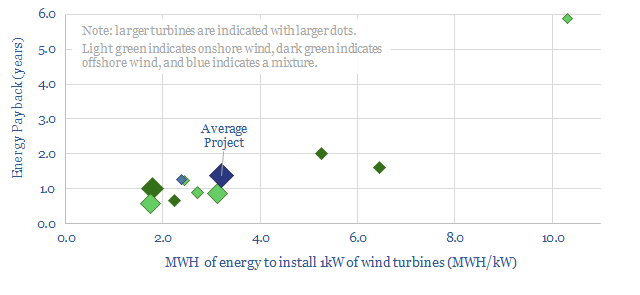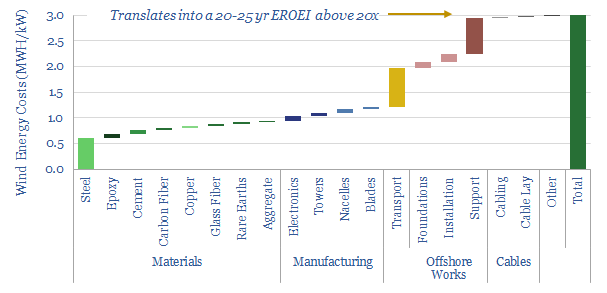Wind power energy paybacks? This data-file estimates 3MWH of energy is consumed in manufacturing and installing 1kW of offshore wind turbines, the energy payback time is usually around 1-year, and total energy return on energy invested (EROEI) will be above 20x. These estimates are based on bottom-up modelling and top-down technical papers.
The average wind energy project has an energy intensity of 3MWH/kW, which is repaid after c1-year, for a total energy return on energy investment above 20x, over a 20-25 year operating life.
One observation from reviewing technical papers is that many have rough methodologies. Some are still basing numbers upon small, <1MW turbines, which are no longer representative. Conversely, others are incomplete, and have not fully captured materials costs.

Hence we have built up our own bottom-up estimates for the energy intensity of wind power, and the EROEI of wind turbines.
Our bottom-up estimates for the energy costs of wind turbines are based on a full bill of materials, economic models of those materials (e.g., glass fiber, carbon fiber, epoxies, steel, copper), data into the vessel days per turbine, and the fuel consumption of different vessels.
Our bottom-up estimates for wind power EROEI also captured power transmission, curtailment considerations and maintenance requirements.
The largest individual contributors to the up-front energy costs of wind turbines are transporting materials to the site (0.75MWH/kW), steel (0.6MWH/kW), other materials (0.3MWH/kW), large offshore vessels that install foundations and turbines (0.3 MWH/kW) and the tail of 20-40 smaller vessels that support offshore operations (data here).
The average CO2 intensity of wind turbines is suggested at 10-20g/kWh (0.01-0.02kg/kWh). This coheres with the technical papers that we reviewed, and our own bottom-up estimates.
Wind power energy paybacks will vary with individual project parameters, and we think that a realistic range for offshore wind projects is 15-30x EROEI.
The most important parameter is the location of the project, which will determine energy generated per year, but also transportation distances and steel requirements.
Comparable data for solar assets is linked here.
